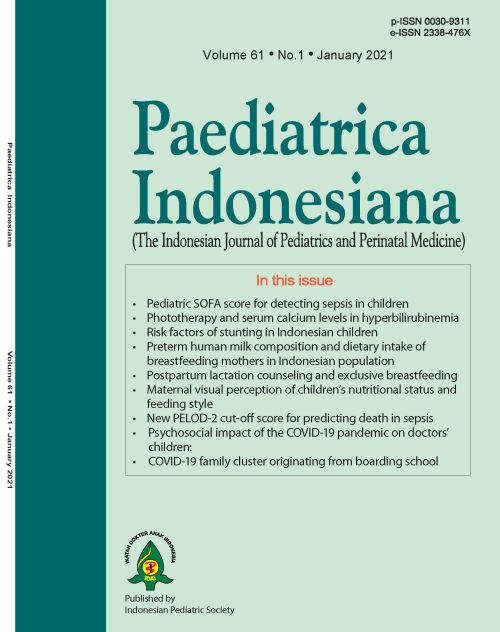Preterm human milk composition and dietary intake of breastfeeding mothers in the Indonesian population
DOI:
https://doi.org/10.14238/pi61.1.2021.20-4Keywords:
macronutrient, human milk, very premature infants, VLBW infantsAbstract
Background Human milk consumption is a protective factor against infection. However, the high variability of human milk composition makes it difficult for clinicians and researchers to assess the adequacy of nutritional intake.
Objective To identify the nutritional profiles and composition of premature human milk and dietary intake of breastfeeding mother.
Methods Human milk specimens were collected from mothers who gave birth to very premature and/or very low birth weight infants. Infants had been admitted to the Neonatology Unit of Dr. Cipto Mangunkusumo Hospital, Jakarta. The milk specimens were analyzed with a mid-infrared milk analyzerTM (MIRIS) for four weeks, and maternal dietary macronutrient intake was determined with food record questionnaires on food consumption frequency and food recall.
Results Significant changes in nutritional composition of human milk were observed, with the fat concentration and calories increasing with time, and protein concentration decreasing with time. There were no significant differences observed in carbohydrate concentration of milk over the four weeks (P=0.447). Maternal intake of protein, carbohydrates, fat and calories was lower than the recommended values for breastfeeding women.
Conclusion The macronutrient (protein and fat) and energy contents of human milk change weekly. Dietary intake of breastfeeding women are lower than recommended values.
References
2. Tagare A, Walawalkar M, Vaidya U. Aggressive parenteral nutrition in sick very low birth weight babies: a randomized controlled trial. Indian Pediatr. 2013;50:954–6. DOI: 10.1007/s13312-013-0258-y
3. Divisi Perinatologi Departemen Ilmu Kesehatan Anak RSCM—FKUI. Fetomaternal data. Jakarta; Neonatology Division, Department of Child Health, Dr. Cipto Mangunkusumo Hospital; 2016.
4. Jarvis C, Budge H. Enteral nutrition and feeding of infants on NICU. Nottingham: Nottingham Neonatal Service; 2019. [cited 2020 January 4]. Available from: https://www.nuh.nhs.uk/download.cfm?doc=docm93jijm4n6644.pdf&ver=14143
5. Edmond K, Bahl R. World Health Organization. Optimal feeding of low birth weight infants: technical review. 2006. [cited 2018 June 6]. Available from: https://apps.who.int/iris/handle/10665/43602.
6. Ballard O, Morrow AL. Human milk composition: nutrients and bioactive factors. Pediatr Clin North Am. 2013;60:49–74. DOI: 10.1016/j.pcl.2012.10.002.
7. Institute of Medicine (US) Food and Nutrition Board. Dietary Reference Intakes: A Risk Assessment Model for Establishing Upper Intake Levels for Nutrients. Washington (DC): National Academies Press (US); 1998. What are Dietary Reference Intakes? [cited 2018 January 4]. Available from: https://www.ncbi.nlm.nih.gov/books/NBK45182/.
8. Fusch G, Rochow N, Choi A, Fusch S, Poeschl S, Ubah AO, et al. Rapid measurement of macronutrients in breast milk: how reliable are infrared milk analyzers? Clin Nutr. 2015;34:465-76. DOI: 10.1016/j.clnu.2014.05.005..
9. Parat S, Groh-Wargo S, Merlino S, Wijer C, Super DM. Validation of mid-infrared spectroscopy for macronutrient analysis of human milk. J Perinatol. 2017;37:822-6. DOI: 10.1038/jp.2017.52.
10. Gidrewicz DA, Fenton TR. A systematic review and meta-analysis of the nutrient content of preterm and term breast milk. BMC Pediatr. 2014;14:216. DOI: 10.1186/1471-2431-14-216.
11. Kementerian Kesehatan Republik Indonesia. Peraturan Menteri Kesehatan RI nomor 75 tahun 2013 tentang AKG yang dianjurkan bagi bangsa Indonesia. 2017. [cited 2017 December 6]. Available from: https://www.gizi.depkes.go.id/download/Kebijakan%20Gizi/Tabel%20AKG.pdf.
12. Boyce C, Watson M, Lazidis G, Reeve S, Dods K, Simmer K, et al. Preterm human milk composition: a systematic literature review. Br J Nutr. 2016;116:1033–45. DOI: 10.1017/S0007114516003007.
13. Hsu YC, Chen CH, Lin MC, Tsai CR, Liang JT, Wang TM. Changes in preterm breast milk nutrient content in the first month. Pediatr Neonatol. 2014;55:449–54. https://doi.org/10.1016/j.pedneo.2014.03.002
14. Ausmeistere L, Ciprovica I, Zavadska D, Andersons J, Volkovs V, Celmalniece K. Impact of maternal diet on human milk composition among lactating women in Latvia. Medicina (Kaunas). 2019;55:173. DOI: 10.3390/medicina55050173.
15. Andreas NJ, Kampmann B, Mehring Le-Doare K. Human breast milk: a review on its composition and bioactivity. Early Hum Dev. 2015;91:629–35. DOI: 10.1016/j.earlhumdev.2015.08.013.
16. Miller EM, Aiello MO, Fujita M, Hinde K, Milligan L, Quinn EA. Field and laboratory methods in human milk research. Am J Hum Biol. 2013;25:1–11. DOI: 10.1002/ajhb.22334.
17. Quinn EA, Largado F, Power M, Kuzawa CW. Predictors of breast milk macronutrient composition in Filipino mothers. Am J Hum Biol. 2012;24:533–40. DOI: 10.1002/ajhb.22266.
18. Lowensohn RI, Stadler DD, Naze C. Current concepts of maternal nutrition. Obstet Gynecol Surv. 2016;71:413–26. DOI: 10.1097/OGX.0000000000000329.
Downloads
Published
How to Cite
Issue
Section
License
Authors who publish with this journal agree to the following terms:
Authors retain copyright and grant the journal right of first publication with the work simultaneously licensed under a Creative Commons Attribution License that allows others to share the work with an acknowledgement of the work's authorship and initial publication in this journal.
Authors are able to enter into separate, additional contractual arrangements for the non-exclusive distribution of the journal's published version of the work (e.g., post it to an institutional repository or publish it in a book), with an acknowledgement of its initial publication in this journal.
Accepted 2021-01-26
Published 2021-01-26


















